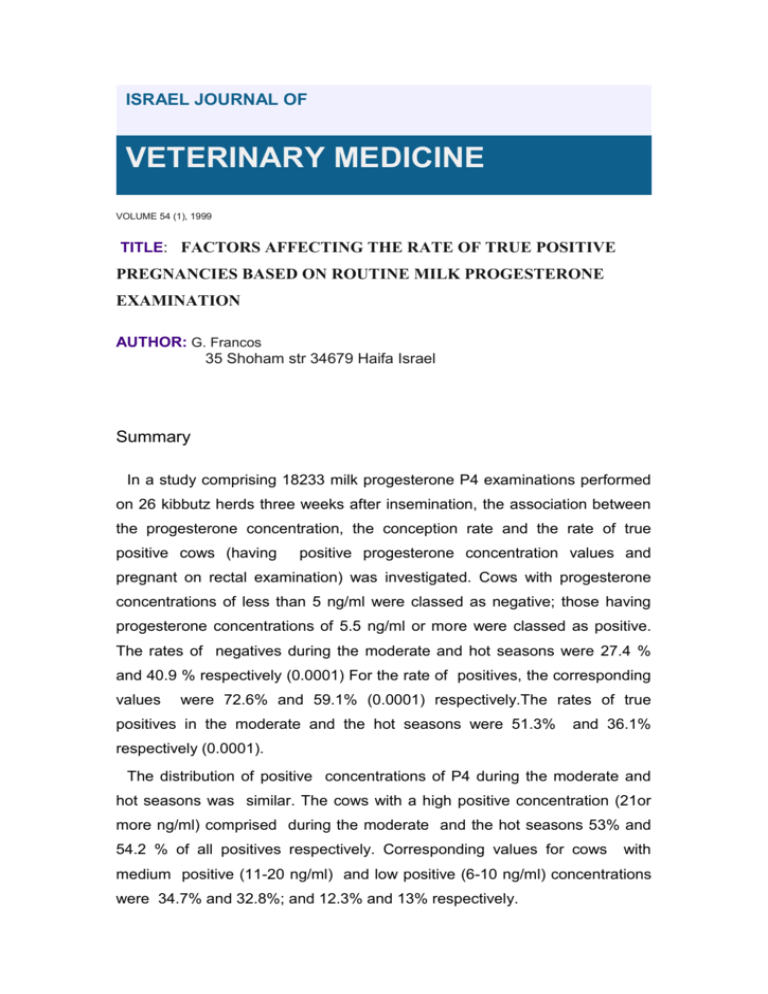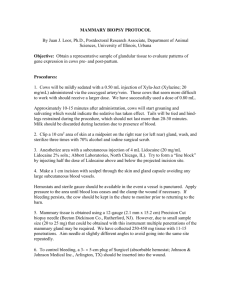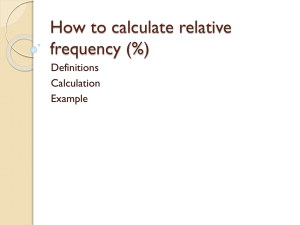factors affecting the rate of true positive pregnancies based on
advertisement

ISRAEL JOURNAL OF VETERINARY MEDICINE VOLUME 54 (1), 1999 TITLE: FACTORS AFFECTING THE RATE OF TRUE POSITIVE PREGNANCIES BASED ON ROUTINE MILK PROGESTERONE EXAMINATION AUTHOR: G. Francos 35 Shoham str 34679 Haifa Israel Summary In a study comprising 18233 milk progesterone P4 examinations performed on 26 kibbutz herds three weeks after insemination, the association between the progesterone concentration, the conception rate and the rate of true positive cows (having positive progesterone concentration values and pregnant on rectal examination) was investigated. Cows with progesterone concentrations of less than 5 ng/ml were classed as negative; those having progesterone concentrations of 5.5 ng/ml or more were classed as positive. The rates of negatives during the moderate and hot seasons were 27.4 % and 40.9 % respectively (0.0001) For the rate of positives, the corresponding values were 72.6% and 59.1% (0.0001) respectively.The rates of true positives in the moderate and the hot seasons were 51.3% and 36.1% respectively (0.0001). The distribution of positive concentrations of P4 during the moderate and hot seasons was similar. The cows with a high positive concentration (21or more ng/ml) comprised during the moderate and the hot seasons 53% and 54.2 % of all positives respectively. Corresponding values for cows with medium positive (11-20 ng/ml) and low positive (6-10 ng/ml) concentrations were 34.7% and 32.8%; and 12.3% and 13% respectively. During the moderate seasons herds with a high average percentage of true positives had higher overall conception rates than cows with medium or low average percentages of true positives (0.00001). Correlation coefficients between overall conception rate and the rate of true positives for the moderate and hot seasons were 0.649 and 0.852 respectively. The correlation coefficient between the overall conception rate and the rate of cows with negative P4 concentrations for these periods was -0.307 and 0.353 respectively. During the moderate seasons in the group of herds with the highest average rate of true positives (59.7 %) and highest conception rate (43.5 %) in the subgroups of cows with low, medium and high positive P4 concentrations, the rate of true positives was 43.6%; 52.6% and 65.7% (0.00001) respectively. In contrast, the group of herds with the lowest average rate of true positives (42.4%) and the lowest conception rates (31.2%) in subgroups of cows with low, medium and high positive progesterone concentrations, the rates of true positives were 29.7%; 41.8% and %(0.0001) respectively. For the two groups the 46.2 of herds with intermediate average rates of true positives (52.8 % and 48.4 %) and conception rates of 37.7 % and 36.1 % the association between P4 values and the rate of true positives was evident as well. The average progesterone values of true positives were significantly higher compared to false positives (0.0001). The average progesterone concentration of positive cows was the same during the moderate and hot seasons. The rate of true positives arriving pregnant to term of rectal pregnancy examination was associated with progesterone concentration three weeks after insemination and with the herd’s conception rate. Further studies on the factors influencing progesterone concentrations three weeks after insemination are indicated. Introduction Examination of progesterone in milk about three weeks after insemination is highly indicative for the early diagnosis of no pregnancy in cows which do not return in visible heat. The studies confirm that 94%-97% of cows with negative progesterone values come in heat or are not pregnant according to routine rectal pregnancy diagnosis (1,2,3,4,5,6). The percentage of true positives, positive by progesterone examination and positive by routine rectal pregnancy examination, according to different studies is within the range of 52%-86% (1,2,3,4,7). Different workers found that the rates of true positives vary strongly between the herds under investigation and emphasized the role of the herd factor (2,5,9,10,11). The discrepancy between the rate of cows apparently pregnant based on progesterone values 19-23 days after the insemination and the rate of pregnancy according to routine rectal examination reflects to a large extent embryonal loss 16 to 35 days post insemination (12), but other factors, such as breeding the cows in luteal phase (13), variation in cycle length (6,13), and incorrect time of artificial insemination (14) are also involved. A significant association was found between progesterone concentrations during the last days of the luteal phase preceeding the first insemination and the conception rate from the first insemination (15,16). An association between progesterone concentrations on days19 to 23 and the conception rate was demonstrated (1,3,9). Francos1998(17) showed that the progesterone concentration three weeks after the first insemination is connected positively with the conception rate during the entire lactation and associated negatively with the incidence of repeat breeders. (cows inseminated four times or more). The aims of this work was to establish the factors influencing the rate of true positives in the herd and to investigate the connection between the progesterone concentration three weeks after insemination and the conception rate. Materials and Methods The study was carried out on 26 Israeli Holstein kibbutz dairy herds comprising about 300 cows and located throughout the country. The annual milk yield was in the range of 8800-10500 kg. As a basis for this work served the reports of examinations of progesterone (P4) in whole milk sent routinely to three district laboratories during 19901992, 20-23 days after insemination, from cows which had not returned to heat by this time. The milk samples were preserved with potassium bichromate. P4 determination was carried out by quantitative enzyme immunoassay using Ovucheck kits (Cambridge Veterinary Sciences. u.k) The reports included following data: the cow’s indentity number, date of sampling and the results of progesterone examinations. P4 concentrations of 5 ng/ml or less were considered negative, while a concentration of 5.5 ng/ml or more was considered positive. For some calculations the positive cows were divided into subgroups of 6-10 ng/ml;(low positive),11-20 ng/ml (medium positive), and 21or more ng/ml (high positive) of progesterone. For one calculation the last subgroup was divided again into 21-25 ng/ml and 26 or more ng/ml subgroups. Altogether data on 18233 examinations were analysed. Additional data related to the cows were obtained from the Israeli Herd Book, which together with the progesterone examination report, were combined in one computerised report which included the following data: Indentity number; date of calving; number of lactations; dates of inseminations and their number; dates and results of progesterone examinations; results of rectal pregnancy examination performed routinely by the veterinary surgeon 40-50 days after insemination. All herds were under intensive veterinary supervision; inseminations were performed by qualified technicians working at the On and Sherut Insemination Centers. Definitions True positive: progesterone-positive cows confirmed pregnant on routine rectal pregnacy examination False positve: progesterone-positive cows returning to heat or found not pregnant True negative: progesterone-negative cows returning to heat or found not pregnant False negative: progesterone-negative cows not returning to heat and found pregnant Average percentage of true positives in the herd= ratio of true total positives to positives. Overall conception rate: (OCR)-all pregnant according to rectal examination X 100 קall inseminations All herds in the study were divided into subgroups according to the herd percentage of true positives in the moderate climatic season as following: Group A: above 57.5 %; group B: 50-57%; group C: 45-49.9%; group D: below 45%. This division was maintained during the hot season. It means that a herd which was classified during the moderate period as belonging to group A was classified as group A during the hot period as well. The calculations of the association between the progesterone concentration and the true positive rate and between average herd true positive rate and the conception rate were performed separately for the moderate and the hot climatic periods. Progesterone examinations which were carried out from July 16 to November 15 were considered as the hot climatic period, while examinations made from November 16 to July 15 were considered as related to the moderate climatic period. Statistics P4 values and the differences in the distribution of P4 values were evaluated by Chi-square test; those of P4 concentration in the cows pregnant and not-pregnant were analyzed by T-test. Coefficient of correlation between conception rate of the herds surveyed the rate of true positives and the rate of negatives were calculated separately for the moderate and hot climatic periods. Results During the moderate and hot periods, negative values were found in 27.4 % and 40.9 % of examinations, respectively; while the corresponding data for positive values were 72.6% and 59.1% respectively (0.0001) (Table1). The percentages of true positives during the moderate and the hot period was 51.3% and 36.1% respectively (p= 0.0001). (Table 1). Table 1: Distribution of negative and positive p4 Vs. concentration..NARY MEDICI Moderate season (% of P4 (ng/ml) % Pregnant all cows) Hot season (% of all cows) % Pregnant < 5.0 27.4 4.0 40.9 1.9 p<0.0001 > 5.5 72.6 51.3 59.1 36.1 p<0.0001 No. of examinations 12524 5709 During the moderate climatic period the distribution of negative and positive values in subgroups A,B,C,D were numerically similar. (Table 2). Table 2: Distribution of negative and positive p4 concentration according to herd group and season: Herd Group Moderate Season Hot Season P4 P4 (No. of examinations <5.5 >5.5 (No. of examinations <5.5 >5.5 A 2495 27.1 72.9 1143 37.7 62.3 B 5671 28.6 71.4 3107 44.2 55.8 C 1640 25.4 74.6 588 44.6 55.4 D 2718 26.4 73.6 871 30.3 69.7 Total 12524 27.4 72.6 5709 40.9 59.1 The rate of medium positive and high positive values from all examinations during the moderate period was higher than in the hot period. (Table 3). Table 3: Distribution of negative and positive p4 concentration according to season: P4 conecentration <5.5 6-10 11-20 21+ total No. of examinations Moderate Season 27.4 8.9 25.2 38.5 100 12524 Hot Season 40.9 7.7 19.4 32 100 5709 p<0.001 p>0.001 Among the cows with positive P4 values, the distribution of low , medium and high positives during the moderate period was not different from those in the hot period. (Table 4). Table 4: Distribution of P4 positive concentration according to season: P4 conecentration 6-10 11-20 20+ total No. of examinations Moderate Season 12.3 34.7 53 100 9092 Hot Season 13 32.8 54.2 100 3374 The percentage of cows in the first lactation with negative P4 values during the moderate period was significantly lower than cows in later lactations. (Table 5). During the moderate and the hot period the percentage of cows with 21or more P4 value was significantly higher in the first lactation than during later lactations. (Table 5). No effect of the insemination number on the distribution of P4 values was found. Table 5: Distribution of P4 positive concentration in the first and following lactation according to season: Moderate period -12524 examinations P4 (ng/ml) First lactation Second lactation < 5.0 25.3 28.6 6-10 7.2 9.7 11-20 22.2 26.6 21+ 45.3 35.1 p<0.00001 Hot period -5709 examinations P4 (ng/ml) First lactation Second lactation < 5.0 40.7 40.9 6-10 6 8.4 11-20 15.1 21.6 21+ 38.2 29.1 p<0.00001 During the moderate period the average percentage of true positives in subgroups A,B,C,D, was 59.7%, 52.8%, 48% and 42.4% respectively. During the hot season the percentage of true positive in A,B,C,D subgroups was 41.9%; 34.%; 33.8% and 35.8% respectively. (Table 6) The differences in the percentage of true positives between subgroups during the moderate season were significant (Table 6), and the differences between subgroup A and subgroups B,C,D during the hot period were also significant (Table 6). Thus an overcarrying effect on the rate of true positive values from the moderate to the hot season was evident for subgroup A only. The percentage of true positives in a given herd subgroup was higher during the moderate than in the hot climatic season. (Table 6). The decrease in the rate of true pregnants between subgroups was connected with a parallel decrease in the conception rate of those subgroups. (Table 6). Table 6: Precentage of true positive and overall conception rate of herds during the seasons: Moderate Period Hot Period Herd Group % True positive OCR % True positive OCR A 59.7 43.5 41.9 26.1a B 52.8 37.7 34.1 19b C 48.8 36.1 37.1 20.6b D 42.4 31.2 33.8 23.6b Total 51.3 38.3 36.1 22 p<0.00001 ab p<0.0001 The coefficient of correlation between the average rate of true pregnants and the conception rate in the moderate and hot season was 0.649 and 0.852, respectively. (Table 7). Table 7: Correlation coefficients between overall conception rate, percentage of true positives and percentage of negatives: % true positive % negative Moderate period 0.649 -0.307 Hot period 0.852 -0.353 The coefficient of correlation between the average rate of negatives and conception rate in the moderate and hot season was -0.307 and -0.353, respectively. In progesterone-positive cows the P4 concentration determined three weeks after insemination had a highly significant effect on the rate of true positives which was lowest in the 6-10 ng/ml subgroup, intermediate in the 11-20 ng/ml subgroup and highest in the 21-25ng/ml and 26 or more ng/ml subgroups. (Table 8) During the moderate climatic season with given P4 positive values belonging to subgroup A had a higher percentage of true positives than cows with the same P4 values belongin to the subgroups B, C or D. The overcarrying effect of these features from the moderate to the hot season was evident for subgroup A only. (Table 8) Thus the percentage of true positives was affected by P4 values determined three weeks after insemination and by the herd status related to the rate of true positives and the conception rate. (Table 8). Table 8: Percentage of true positives in groups of cows with different positive P4 concentrations. Herd Group 6-10 P4 (ng/mg) 11-20 21-25 26+ Moderate season A 43.6 52.8 64.3 67.1 p<0.00001 B 40.9 50.1 54.7 58 p<0.00001 C 33.6 46 50.9 53.3 p<0.05 D 29.7 41.8 41.9 50.5 p<0.0001 Hot Season 25 37.4 45.1 50.6 p<0.00008 17.3 32.4 38.7 40.8 p<0.00001 14.3 28.8 42.6 50.9 p<0.00009 14 28.9 36.4 39.9 p<0.0014 True positive cows found pregnant according to rectal examination had significantly higher P4 values three week after insemination, compared to false positive cows returning to heat or not pregnant on rectal examination. (Table 9) There was no difference in the average progesterone concentration of positive cows between the moderate and the hot seasons. (Table 10). Table 9: Average progesterone concentrations of true and false positive T-test. Season Moderate season Hot Season X S.D X S.D True positive 22.4361 7.670 23.2897 7.568 False Positive 20.2852 8.145 20.5713 8.312 Signif. 0.0001 0.0001 Table 10: Average progesterone concentrations of positive cow T-test. No. of Examinations X S.D Moderate Season 9092 21.3883 7.978 Hot Season 3374 21.5537 8.155 Signif 0.307 Discussion The distribution of progesterone concentration. The rates of the negative and the positive P4 concentrations examined three weeks after insemination during the moderate climatic season were 27.4% and 72% respectively. (Table 1) Other studies report similar rate of negative concentrations (27.2-29.4%) (3,9,18) with very similar rates of positive P4 concentrations (% negative +%positive =100%) to those found in our study. The rate of true positives from all positives during the moderate season being 51.3% (Table 1) is considerably lower compared to the reports of 81.2% (18) or 71%-73% rate for true positives (1,2,3) but similar to the results of (53.7%) (9) and not far from the findings of 60% (4) and (64.3%) (5). In this study 96 % of the cows with negative P4 concentration were not pregnant on the rectal examination (Table 1) close to other reports. (1,3,4) The rate of false positives reflects to a considerable extent the incidence of late embryonal death, (12) occurring from the time of progesterone examination and until the time of the rectal or ultrasound negative pregnancy examination. The rate of negative concentrations reflects a fertilisation failure or early embryonal deaths occurring before the term of P4 examination (19) During the hot season the rates of negative concentrations were considerably higher and the rates of positive concentrations considerably lower compared to the moderate climatic season. (Table 1) It appears therefore that heat stress contributes to the increased rate of early (until 20 days post-insemination) and late embryonal death. The distribution of low, medium and high positives was similar in the moderate and hot seasons indicating a trend of relatively constant distribution of P4 concentrations in the positive group (Table 4) Similarly the average P4 value in the positive group during the hot and moderate season were similar (Table 10) and is consistent with ref.12. The rate of 51.3% true positives from all positives is an average of 9092 examinations performed in 26 herds during the moderate climatic season. (Table 6) In the subgroups the rate of true positives was in the range of 42.4% to 59.7%. (Table 6) The diversity in the rate of true positives reported in this and in other studies - from 42.4% to 81.2% (1,5,9,18) indicates that the rate of false positives ranging from 19.8 % to 57.6 % is extremely wide. It is generally thought that most embryo mortality occurs until 20 days post insemination. (10,20,21)This claim is supported by the low estimates of late embryonal death (4.8%-6%) in a series of studies (18,22,23) In some later studies the revised estimates of late embryonal death are considerably higher 22%-29 %. (10,11) There is evidence for an increase in the rate of late embryonal deaths as a result of possible stress associated with breeding or management for high level milk production. (10,11,24) The high rates of false positives in a recent study performed in high producing herds are in accordance with these assumptions. During the moderate and the hot climatic seasons a correlation of 0.64-0.85 was found between the percent of true positives and between the overall conception rate of cows in surveyed herds. The correlation between the overall conception rate and the rate of negative values is much lower and is negative -0.30 and -0.35 (Table 7) what leads to the conclusion that one of the main factors connected with low herd fertility is the high incidence of late embryonal death as reflected by the low rate of true positives. The term of routine P4 coincides with the period of implantation. (10) It seems therefore that in low fertility, high producing dairy herds late embryonal death is more important as a pregnancy reducing factor than early embryonal death occurring before 20 days after insemination. It is likely that uterine rather than embryonical factors are responsible for the late embryonal death. (10) In an extensive epidemiological study, nutritional factors explained 67% of the differences in kibbutz herds conception rates. (25) It is postulated that nutritional imbalances occuring in high producing herds contribute to the creation of unfavorable uterine environment detrimental for embryos in the phase of implantation and a high rate of late embryonal death in consequence. Average progesterone concentrations in true-and false - positive cows. In the progesterone-positive cows, the average P4 values were significant higher in the true positive compared to the false positive cows. (Table 9) The differences in the milk progesterone concentrations between inseminated cows subsequently shown not to be pregnant and those subsequently diagnosed as pregnant were reported by others. (26,27,28,29). These differences, although highly significant, do not have any predictive use because in absolute values they are small. The association between the progesterone concentration and the rate of true positives Progesterone concentrations estimated three weeks after insemination appeared to be important factor in determining the rate of true positives cows arriving pregnant to the term of routine rectal examination. During the moderate climatic season the rate of true positives was lowest in the low positive group (6-10 ng/ml), intermediate in the medium positive group (11-20 ng/ml), and highest in the high positive group (21or more ng/ml). The differences being prevalently highly significant. (Table 8) The same trend was evident during the hot season, but the rate of true positives was lower than in the moderate period. (Table 8) The connection between progesterone values on days 19 through 23 and the chances of pregnancy were demonstrated in other studies. (1,9) Cows with P4 values of 21+ ng/ml had the biggest chances of pregnancy. In our study 53-54.2% of all cows with positive values. (Table 4) The rank of the herd according to the average rate of true positives was another significant factor influencing the rate of true positives in low-medium and high positive subgroups. During the moderate season, low positive cows in subgroup A had a rate of true positives of 43.6 %. In subgroup D the rate of true positives of low positive cows was 29.7 % only (Table 8). Medium positive cows of subgroup A had a rate of true positives of 52.8 % compared to 41.8% of true positives in subgroup D. The same trend was evident for high positive subgroups. (Table 8). During the hot season herds in subgroup A had higher true positive rates than the other three subgroups. (Table 8) It should be remembered that for the hot season the division of the herds into groups A to D was made according to the herd status during the moderate season and not according to the actual herd status. High correlation coefficient between overall conception rate and percentage of true positives during the moderate and the hot seasons (Table 7) as well the association between the average percentage of true positives in the subgroups and the overall conception rate of these subgroups during the moderate season (Table 6) demonstrated the association between the conception rate and the rate of true positives of the herd. It is probable, therefore, that the big differences in the rates of true positives reported in the various investigations discussed above were connected with differences in the conception rate of the herds in which the investigations were conducted. The average progesterone concentration of positive cows examined three weeks after insemination was not influenced by the climate (Table 10). This was consistent with ref.12. On the other hand the rate of true positives that were pregnant on rectal examination during the hot season was highly significantly lower compared to the moderate season (36.1% v. 51.3 % (Table 1). It appears therefore that the increased rates of embryonal loss and not the lowered progesterone concentration as proposed (7) are responsible for low conception rates during the hot season. Conclusions Progesterone concentrations measured by milk examinations performed three weeks after insemination and the interaction between the rate of true positives and the conception rate are important factors subsequently influencing the rate of cows pregnant at routine rectal examination. Further studies for the determination of the factors influencing progesterone concentrations three weeks after the insemination, particularly after the first insemination, would provide information useful for planing measures to improve the fertility of high producing dairy herds. References 1. Cavestany D., and Foote R.H. The use of milk progesterone and electronic vaginal probes as aids in large dairy herd reproductive management. Cornell Vet. 75:441-453, 1985 2. Pennigton J.A., Schulz L.H. and Hoffman W.F. Comparison of pregnancy diagnosis by milk progesterone on day 21 and day 24 postbreeding:Field study in dairy cattle J. Dairy Sci 68: 2740-2745 3. Rajamahandrem R., Burton B., and Shelford J. A field study on usefulness of milk progesterone determination to confirm estrus and pregnancy of dairy cows in Fraser Valley area of British Columbia. Can. Vet. J. 34: 349352, 1993 4. Kovacevic R., Krsmanovic L., Maric D., Perkucin R.,and Veselinovic S. Investigetion of hormone profiles in dairy cattle with a view to controlling fertility and increasing reproductive efficiency. In proceeding of the coordination meeting on isotope aided studies on livestock productivity in Mediterranean and North African countries 255-274 1988 Rabat 5. Markusfeld (Nir) O., Nahari N., and Adler H. A routine 21 to 23/24 postservice milk progesterone monitoring for reducing the interinsemination interval in dairy cows. Isr. J. Vet. Med. 44, 111-119 1989 6. Gowan E.N., Etches R.J., Bryden C., and King C.J. Factors affecting accuracy of pregnancy diagnosis in cattle. J. Dairy Sci. 65:1294-1302 1982 7. Markusfeld (Nir) O., Adler H., Nahari N., and Kessner D. Impaired summer fertility associated with lower milk progesterone levels in dairy cows. Isr. J. Vet. Med. 46:54-56 1991 8. Noseir M.B., Gyawu P., and Pope G.S. Progesterone concentration in defatted milk of dairy cows in early pregnancy. Br. Vet. J. 148: 45-53 1992 9. Klawonn W.,Leschhorn E.,and Jonas D. Milchprogesterontest: Ausagewert und-sicherheit im Routineinsatz durch den Landwirt. Mh. Vet.-Med. 47:187192 1992 10. Ball P.J.H., Later embryo and early fetal mortality in the cow Animal Breeding. Abstracts 65: 167-175 1997 11. Pursley J., R.Silcox R.W., and Wiltbank M.C. Effect of time of artificial insemination on pregnancy rates, calving rates,pregnancy loss and gender ratio after synchronization of ovulation in lactating cows. J.Dairy Sci 81:2139-2144 1988 12. Howell J.L., Fuquay J.W. and Smith A.E. Corpus luteum growth and function in lactating Holstein cows during spring and summer.J.Dairy Sci 77:735-739 13. Wimpy T.H., Chang C.H.,Estergreen V.L. and Hillers J.K. Milk progesterone enzyme immunoassay: Modification and a field trial for progesterone detection in dairy cows. J. Dairy Sci. 69:1115-1121 1986 14. Noakes D. Pregnancy diagnosis in cattle. In Practice March, 46-51, 1985 15. Folman Y.,Rosenberg M., Herz Z. and Davidson M.The relationship between plasma progesterone concentration and conception in post-partum dairy cows maintained on two levels of nutrition. J. Reprod. Fert. 34 267278 1973. 16. Fonseca. F.A., Britt J.H., McDaniel B.T., Wilk J.C. and Rakes A.H. Reproductive traits of Holstein and Jerseys, Effects of age, milk yield and clinical abnormalities on involution of cervix and uterus, ovulation, estrus cycles, detection of estrus, conception rate and days open. J.Dairy Sci 66:1128-1148,1983 17. Francos G. Association between milk progesterone concentration after first insemination and conception in dairy cattle in Israel. Vet. Record. 142,63-64 1998. 18. Humblot P., Dalla Porta M.A. Effect of conceptus removal and intrauterine administration of conceptus tissue on luteal function in the cow. Reprod. Nutr. Develop. 24: 529-541 1984. 19. Kastelic J.P. Noninfectious ebryonic loss in cattle. Veterinary Medicine 584-589 June 1994. 20. Sreenan J.M., and Diskin M.G. Early embryonic mortality in the cow: its relationship with progesterone concentration. Vet.Record. 112:517-521 1983. 21. Sheldon M. Bovine fertility-practical implications of the maternal recognition of pregnancy.In Practice 546-556 November/December 1997. 22. Moller K., Lapwood K.R. and Marchant R.M. Prolonged service intervals in cattle. New Zealand Vet. J. 34:128-132 1986. 23. Baxter S.J., and Ward W.R. Incidence of fetal loss in dairy cattle after pregnancy diagnosis using an ultrasound scanner. Vet. Record. 140:287288 1997. 24. Peters A.R. Embryo mortality in the cow Animal Breeding. Abstracts 64:587-598,1996. 25. Francos G., Distl O., Kraeusslich H., and Mayer E. Epidemiological study on factors influencing fertility indices in Israeli dairy herds. Theriogenology 38:385-405, 1992. 26. Bulman D.C., and Lamming G.E. Milk progesterone levels in relation to conception, repeat breeding and factors influencing acyclity in dairy cows. J. Reprod. Fert. 54,447-458, 1978. 27. Kastelic J.P.,Bergfelt D.R., and O.J. Ginther Relationship between ultrasonic assesment of the corpus luteum and plasma progesterone concentration in heifers. Theriogenology 33: 1269-1278, 1990. 28 .Larson S.F., Butler W.R., and W.B. Currie Reduced fertility associated with low progesterone postbreeding and increased milk urea nitrogen in lactating cows. J. Dairy Sci 80:1288-1295, 1997. 29.Hansel W. Plasma hormone concentrations associated with early embryonal mortality in heifers. J. Reprod. Fert. 30: 231-239, 1981.









